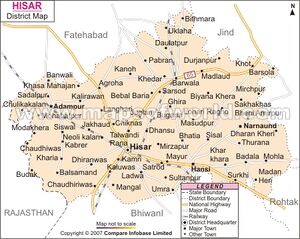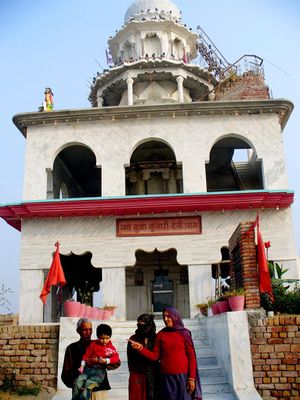Kanwari
- For Gotra see Kanwari Gotra
Kanwari (कंवारी), also spelled as 'Kunwari' or 'Kwari', is a village in Hansi Tehsil of Hissar District in Haryana State of India. It is site of Indus Valley Civilization.
Contents
Location
It is situated 24km from Hissar city on Hissar to Tosham Road which leads to Bhiwani.
Group as Satbaas
Kanwari (कंवारी) is part of a eight-village grouping, called Satbas (सतबास) Khap (brotherhood clan of seven villages). Satbas Khap includes Kanwari (कंवारी), Rakhi Khas, Ramayan Gaon (रामायण गांव), Dhandheri (ढंढेरी), Depal (देपल), Umra (उमरा) & Sultanpur (सुल्तानपुर), Muzadpur (मुजादपुर) - all together known as SATBASS. Umra (उमरा) and Sultanpur (सुल्तानपुर) were considered as one village as part of the original Satbas (सतबास) Khap, hence the name. People from this Satbas (सतबास) Khap brotherhood or clanship are considered to be siblings and can not marry within this khap.
History
Kanwari is an ancient town, existing for hundreds of years during Tomar Rajput Kings, later under Slave Dynasty of Delhi, Mughals, Marathas, Jat Sikh rulers and eventually under British rule. After Independence, Kanwari became part of Punjab. Once Haryana was formed as a separate state on 1st November 1966, Kanwari became part of Haryana falling under Hissar District. Wikimapia link to Kanwari can be found here.
During excavation at Kurdi (ancient rubbish dump), site with early gray ware and ancient materials was found [1] (Silak Ram, 1972, unpublished thesis from Kurukshetra University).
Kanwari has an old Shiva temple called 'Baba Siri Gir' and Akhara (abode) for sadhus (Hindu mystics) as well as a temple of village deity called 'Bua Kanwari' (Virgin Aunty Deity) where newly weds go for the blessings before entring the village. During recent renovation and expansion of Bua Kanwari temple, excavations were carried out during 2001-2003 and ancient stone statues of Hindu deities were found. These stone statues are yet to be carbon dated or examined by the trained archaeologists. Currently, these statues are stored in the basement under the temple.
Administration
Kanwari is an administrative unit and has democratically panchayat samiti. Kanwari has been some times aligned to Hansi Tehsil and Vidhan Sabha constituency in Hissar District and other times Kanwari has been aligned to the Bawani Khera Tehsil and Vidhan Sabha constituency in Bhiwani district.
Kanwari is under Hissar Lok Sabha Constituency.
Kanwari also has a Patwari (government land record officer) and ADO (Assistant Development Officer, for development of agricultural activities) based at kanwari.
Village is sub-divided in various 'Panna' (sub-sectors), such as 'Parla Panna' (the Upper sub-sector), 'Nichla Panna' (the Lower sub-sector) and 'Bahrla Panna' (the Outer sub-sector).
Demographics
Kanwari has a population of 5,119, out of which 2407 are female.
All of the people living in the village are Hindus. Majority of people living in the village are Jats. There are also brahmins, Lohar, Khati, Balmiki, Harijans, Nai, Baniya and other Hindu castes.
There were a couple of Kumhar families who were converted to Islam during Mughal rules. After 1947 India-Pakistan partition these families were reconverted to and accepted into Hindu religion.
As per 2001 census, demographics of Kanwari villages are [2]:
- No of Households 896,
- Total Population 5119,
- Male Population 2712,
- Female Population 2407,
- Population below 06 yrs 835,
- Population below 06 Male 427,
- Population below 06 Female 408,
- Total Agriculture Labour 180,
- Marginal Agriculture Labour - Male 32,
- Marginal Agriculture Labour - Female 148,
- Literate Polulation 2655,
- Male Literate 1739,
- Female Literate 916,
- Illiterate Population 2464,
- Male illiterate population 973,
- Female illiterate population 1491,
- Working Population 2581,
- Main working population 799,
- Main Working Population Male 220,
- Main Working Population Female 579,
- Total Casual Working Population 385,
- Main Casual Working Population Male 87,
- Main Casual Working Population Female 298,
- Total Number of SC 1068,
- Number of SC Population - Male 597,
- Number of SC Population - Female 471,
- Number of ST 0,
- ST Population - Male 0,
- ST Population - Female 0
As per July 2010 official report[3], Kanwari has a 1147 households with a total population of 5733 with 1196 Scheduled Caste habitants.
Geography, Climate and Irrigation
Southwest of Kanwari is desert land and rest of the area surrounding kanwari is fertile plain land. Kanwari has three large ponds (Johad) e.g. Bada Johad (big pond), Jharna (Filter Pond) and Mundhala Johad. Fields of Kanwari are irrigated by the 'Sunder sub-Branch' extension of the 'Hansi-Butana Branch' of the Western Jamuna Canal.
Hisar has a continental climate, with very hot summers and relatively cool winters. Summer starts in April and lasts till the middle of October. May is the hottest month, with the maximum day temperatures in the 48 °C (118 °F) range. Hisar experiences a weak monsoon, from late June to September, with about 15 inches (380 mm) of rain. Winter starts in November and is mild and sunny, although temperatures may reach freezing on some nights. It is a semi-arid region and agriculture is supported mainly by canals and ground water irrigation. Hisar lies just 30 km north-east of the Thar Desert. Hot winds, locally known as Loo, are strong and frequent from May to July. Intermittent dust storms are also common. In the winter some rain is received due to western disturbances. The climate of the district is characterised by its dryness and extremes of temperature and scanty rainfall. The year may be divided into four seasons. The cold season from November to March is followed by the summer -season Which lasts up to the end of June. The period from July to about the mid of September is the south-west monsoon season. The latter half of September and October constitute the post monsoon or transitional period.
Transport Connectivity
Kanwari is well connected by road. Kanwari lies 25km from Hissar to the North-East, 6km from Nalwa 15km from Tosham and 35km from Bhiwani to the South-West on Hissar-Tosham-Bhiwani road.
Famous industrialist O.P Jindal was born at Nalwa, his widowed wife is now Asia's richest woman with personal fortune of USD12.2billon[4][5][6][7] .
At Kanwari there is another link road that leads to Hansi - 25km. Kanwari is also connected to another village Badayan Jattan via a 4km link road.
Education
Kanwari has a two government schools and a COllege of Education.
- Girl's Secondary Government school
- Senior Secondary Government school
- RDS College of Education
There is a Government Degree college at Nalwa (6km from Kanwari). There are many more educational institutes at Hissar - 24km.
Jat Gotras
Notable persons
- Village has been prominent contributor to Indian National Army(Azaad hind Fauz) Three notable freedom fighter who fought for their motherland are
- 1. Freedom fighter AMAR SINGH JAKHAR
- 2. Freedom fighter RISHAL SINGH Duhan later his son Samsher Duhan became Zilla Parishad
- 3. Freedom fighter RAMESHWAR Duhan later his son Late Mahabir Duhan became sarpanch
- Dhoop Singh Sarpanch Duhan
- Sanjay sarpanch Duhan
- Bhupsingh sarpanch Duhan
- Prakash Singh Duhan
- Choudhary Rattan Singh Sheoran S/O Choudhary Ganpat Ram Sheoran (Bhailiwala)
- Sube Singh Sheoran
- Balbir Singh Sheoran ( Retired Principal)
- Gyani Singh Duhan
- Gyani Singh Sheoran
- Satyavir Singh Sheoran
- Nandlal Sheoran
- Purushottam Singh Sheoran
- Satvir Singh Sarpanch Jakhad
- Sube Singh Dhanda
- Jangvir Singh s/o Hari Singh Gadwal
- Dharmender Kanwari (Sheoran) - Journalist (Politics)
Also See
- Bawani Khera City and Tehsil
- Bhiwani City and Tehsil
- Dhillon Dhillon
- Fatehabad
- Hansi City and Tehsil
- Haryana
- Hisar district
- Hisar, Haryana city
- Hisar (Lok Sabha constituency)
- India
- Kanwari (Haryana, India)
- List of Constituencies of the Lok Sabha
- Nalwa
- Siwani City and Tehsil
- Balsamand
- Harita
- Kaimri
- Daya
- Juglan
- Mangali
- Sultanput
- Umra
External Links and Sources
- Facts and figures regarding Kanwari village - villageinfo.in website
- http://www.findmessages.com/bua-kanwari-temple-hisar
- http://ourvillageindia.org/Place.aspx?PID=183203
References
- ↑ http://books.google.com.sg/books?id=law3AAAAIAAJ&pg=PA244&lpg=PA244&dq=hisar+kunwari&source=bl&ots=Wu9yO-dR9g&sig=FcG_IWwNIM-TXWp-5s2HR04nIP4&hl=en&ei=iDErTJfTAsiXrAel4qF1&sa=X&oi=book_result&ct=result&resnum=3&ved=0CBsQ6AEwAjgK#v=onepage&q&f=false
- ↑ http://www.voiceofbharat.org/hisar/view_results_detail.asp?ID=328&mVarTable=[Sheet1]
- ↑ http://ddws.gov.in/ddwsimis/RuralWaterSupply/Reports/ReportYSRHabitationDistrict.aspx?districtId=0154&districtname=HISAR
- ↑ http://article.wn.com/view/2010/03/12/Forbes_lists_Savitri_Jindal_as_richest_woman_of_India_at_122/
- ↑ http://in.reuters.com/article/idINIndia-48277620100506
- ↑ http://en.wikipedia.org/wiki/Savitri_Jindal
- ↑ http://www.newsofap.com/newsofap-14555-25-savitri-jindal-is-asiaa-richest-woman-newsofap.html

